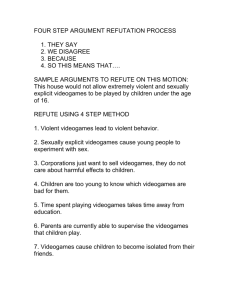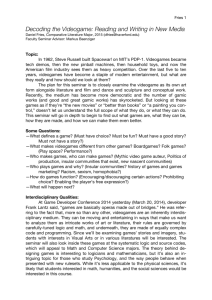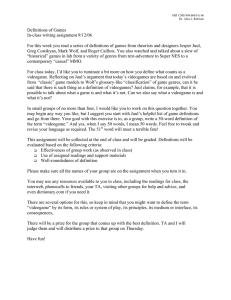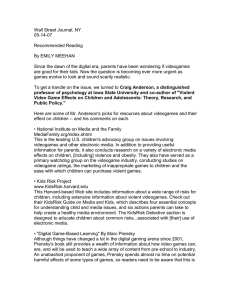Game-like Simulations for Online Adaptive Learning: A Case Study
advertisement
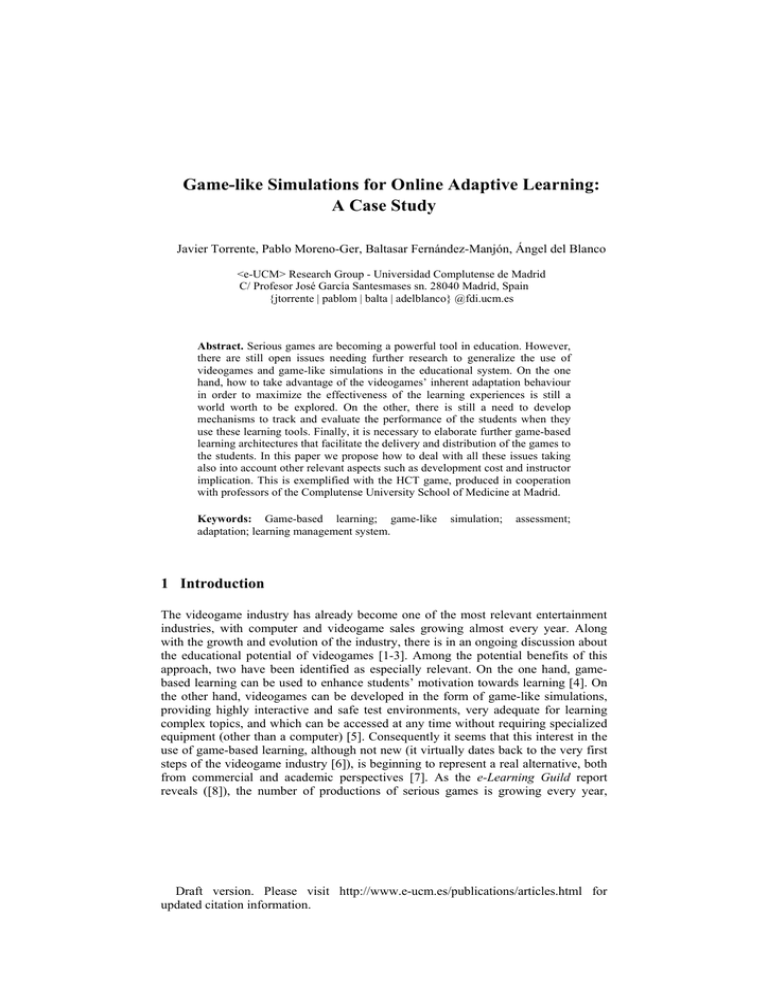
Game-like Simulations for Online Adaptive Learning:
A Case Study
Javier Torrente, Pablo Moreno-Ger, Baltasar Fernández-Manjón, Ángel del Blanco
<e-UCM> Research Group - Universidad Complutense de Madrid
C/ Profesor José García Santesmases sn. 28040 Madrid, Spain
{jtorrente | pablom | balta | adelblanco} @fdi.ucm.es
Abstract. Serious games are becoming a powerful tool in education. However,
there are still open issues needing further research to generalize the use of
videogames and game-like simulations in the educational system. On the one
hand, how to take advantage of the videogames’ inherent adaptation behaviour
in order to maximize the effectiveness of the learning experiences is still a
world worth to be explored. On the other, there is still a need to develop
mechanisms to track and evaluate the performance of the students when they
use these learning tools. Finally, it is necessary to elaborate further game-based
learning architectures that facilitate the delivery and distribution of the games to
the students. In this paper we propose how to deal with all these issues taking
also into account other relevant aspects such as development cost and instructor
implication. This is exemplified with the HCT game, produced in cooperation
with professors of the Complutense University School of Medicine at Madrid.
Keywords: Game-based learning; game-like
adaptation; learning management system.
simulation;
assessment;
1 Introduction
The videogame industry has already become one of the most relevant entertainment
industries, with computer and videogame sales growing almost every year. Along
with the growth and evolution of the industry, there is in an ongoing discussion about
the educational potential of videogames [1-3]. Among the potential benefits of this
approach, two have been identified as especially relevant. On the one hand, gamebased learning can be used to enhance students’ motivation towards learning [4]. On
the other hand, videogames can be developed in the form of game-like simulations,
providing highly interactive and safe test environments, very adequate for learning
complex topics, and which can be accessed at any time without requiring specialized
equipment (other than a computer) [5]. Consequently it seems that this interest in the
use of game-based learning, although not new (it virtually dates back to the very first
steps of the videogame industry [6]), is beginning to represent a real alternative, both
from commercial and academic perspectives [7]. As the e-Learning Guild report
reveals ([8]), the number of productions of serious games is growing every year,
Draft version. Please visit http://www.e-ucm.es/publications/articles.html for
updated citation information.
along with the number of organizations adopting this kind of learning for their staff
training programs.
However, there are still some open issues requiring further research and discussion.
Educational videogames have their own needs, which do not always converge with
the requirements of classic videogame development methodologies [9].
First, videogames are not always easy to distribute and deploy. In educational
contexts this can be a real burden for instructors when games have to be distributed to
many students, and the results of the game experiences must be collected and
processed manually. Besides, game-based learning needs to track the performance of
the students to check whether the learning goals are achieved or not [10], a feature
that is not very common in commercial videogames.
In addition, educational videogames and game-like simulations need to adapt their
behaviour according to the profile of the player (i.e. student) in order to cater for the
special needs of each student [11]. Commercial videogames are inherently adaptive,
but there are still few initiatives trying to ease the design and integration of adaptive
behaviour in educational videogames. Finally there are other issues, such as
development cost and the difficulties of involving instructors and content experts in
the development process.
In this paper we exemplify through a case study how the <e-Adventure>
educational game platform [12] addresses these issues, describing the development of
a low-cost, adaptive and assessable game-like simulation in the field of Medicine
education. The game covers the procedure to measure Hematocrit levels on a blood
sample, and was developed with the participation of professors from the School of
Medicine at the Complutense University of Madrid.
The paper is structured as follows: in section 2 we discuss some issues related to
adaptation, development and deployment of educational videogames. In section 3, a
brief description of the <e-Adventure> platform is given. In section 4 we provide a
full description of the case study. In section 5 we present a direct experience with
students and some evaluation of the results, and in section 6 we present some
conclusions and future lines of work.
2 Games and education: challenges and issues
In this section we discuss two aspects that are tightly related to the work we are
presenting. First we introduce adaptive learning and how this can be achieved through
videogames. Then, we describe some of the issues that must be addressed when
developing educational games and game-like simulations.
2.1 Adaptation in Learning and Videogames
During the last years, there is a steadily growing trend towards adaptive learning,
especially focused in online learning systems [13, 14]. The idea is to personalize the
content and flow of the learning experience for each student, taking into account their
individual context to maximize the effectiveness of the learning experience. This
adaptation can consider different aspects, such as user preferences, different levels of
Draft version. Please visit http://www.e-ucm.es/publications/articles.html for
updated citation information.
prior knowledge, cultural conditions, and even learning styles (e.g. exploratory vs.
guided).
In this context educational videogames can be very helpful as games are inherently
adaptive. Commercial pressure pushes videogame developers to personalize the game
experiences as much as possible, in order to widen the spectrum of potential
customers and maximize their engagement when playing the games. Therefore it is
very usual to see videogames catering for different gaming styles and skills, offering
for instance diverse difficulty settings. In addition, unlike other content videogames
are extremely interactive. The interaction between user and videogame can be used to
gauge the game behaviour. For instance, it can be detected transparently if the user is
stuck trying to solve a puzzle, and then give a clue or lessen the difficulty of the task
slightly [15]. In short, adaptation mechanisms in videogames are now much more
fine-grained than a simple difficulty level choice.
There are interesting works identifying the characteristics of videogames that are
better for implementing adaptive behaviours and how to design adaptive videogames
[16]. Nonetheless it is difficult to see authoring tools and learning models supporting
the modelling and implementation of adaptive behaviours in videogames [17].
2.2 Videogame Development and Deployment
During the last years, several development tools have appeared trying to ease the
production of videogames, including game engines, IDEs (Integrated Development
Environment), and user-friendly authoring tools. The range of possibilities is massive,
going from very simple open source projects to complex professional tools.
A great example is the Torque™ game engine, published by GarageGames™
which allows users to produce top-tier computer games for different platforms.
Another good example is Microsoft™’s XNA™ development environment, which is
being used in the development of numerous videogames for both PC and XBOX™
platforms. Besides, there are lots of authoring tools aiming to encapsulate the most
complex aspects of videogame development, facilitating the production of
videogames by people with no technical skills. Some good examples are the tools
developed by The Game Creators, Unity3D™ or GameMaker™.
In spite of all these initiatives there are still open issues which have not been
completely addressed yet, especially for educational gaming. On the one hand
videogames are not easy to distribute and deploy in educational settings. On the other
hand, these platforms do not cope with the specific needs of the educational gaming
field, such as the need of tracking and evaluation of the progress of the student or
adaptation to the student special requirements.
These inconveniences can be lessened by integrating the educational videogames
and game-like simulations in the widely extended e-Learning environments (the so
called Virtual Campus, Learning Management Systems or LMS) [18]. These
environments allow instructors (i.e. teachers and professors) to organize courses and
lessons for students, and are becoming a common tool not only for distance learning
programmes but also as a complement in traditional classes. Besides, modern LMS do
not only store content for remote students, as they are complex web applications that
allow instructors to track the activity of the students and manage their learning
Draft version. Please visit http://www.e-ucm.es/publications/articles.html for
updated citation information.
experiences. These systems usually offer facilities to evaluate the students and to store
information about their activity. This process is usually performed following
standards and specifications that allow the content interoperability between the
different competing platforms [14]. Therefore the content must be developed and
packaged in compliance with these standards and specifications to be deployed in a
LMS. These standardized content packages are usually known as Learning Objects.
Unfortunately, most game development tools lack the proper mechanisms to support
the encapsulation of the games as Learning Objects.
3 The <e-Adventure> Platform
<e-Adventure> is an authoring platform for the production of point-and-click
educational adventures, which has been used in the development of diverse
educational games and low-cost game-based simulations in multiple contexts, as for
instance, the medical education field [19]. Besides, <e-Adventure> present some
additional features especially oriented to education.
Point-and-click adventure games are quite cheap to produce in comparison to
other, more sophisticated game genres. This makes the production of <e-Adventure>
games affordable even with small educational budgets. In addition, the <eAdventure> platform was designed with instructors in mind, providing a friendly
authoring environment [12] and an instructor-centered development process model
[20]. The main advantage of this approach is that instructors can be directly involved
in the production of the games.
<e-Adventure> also provides education-specific features that are not typically
found in commercial games or game development tools. One of these features is the
possibility to define assessment rules in the games that are triggered when a set of
conditions on the “state” of the games are satisfied. The effect will be that the grade
of the student is changed according to the definition provided by the author of the
game (i.e. the grade is set to a value, incremented or decremented). When the game is
completed an assessment report is generated with all this information. Besides, <eAdventure> games can take advantage of the high interactivity in the games to adapt
their behaviour according to a set of rules defined by the author of the game [11].
Finally, the games produced with <e-Adventure> can be packaged as Learning
Objects, easing the delivery of the games to the end users. When an <e-Adventure>
game is delivered through a standards-compliant LMS, the assessment and adaptation
mechanisms described above can be linked to the central server. The tracking reports
and the computed grades can be sent to the LMS for automatic processing; then
instructors can access the results via web. Alternatively, the information can be
displayed to the students as feedback. Similarly, the adaptation mechanism can be
used as input for the adaptation decisions stored in the student’s profile at the LMS
side
Draft version. Please visit http://www.e-ucm.es/publications/articles.html for
updated citation information.
4 Case Study: The HCT Blood Test Game
For a long time teachers of Human Physiology, a module taught in the second year of
the Degree in Medicine at Complutense University of Madrid, have identified diverse
difficulties that students usually have when working in practical lab sessions,
especially the first time they have to use the equipment. In this module students must
complete various practical lab sessions where they test multiple properties of the
Hematocrit (HCT) and learn to measure HCT levels through a classic HCT Blood
Test. The attendance to these practical sessions is compulsory for all the students,
although the results are not directly considered for the final grade of the module,
which lessens the students’ motivation.
In addition, in order to prevent potential infections and according to current
Spanish health regulations, the blood used in these practical exercises must be drawn
from laboratory rats that must be sacrificed. This means that, for ethical reasons,
blood samples are scarce, while the number of students enrolled in this module every
year is rather high (around 400 students). As a consequence the lab time is scant and
must be administrated carefully.
We considered that creating a game-like simulation of these exercises would
increase the motivation of the students. Moreover, a game-like simulation would help
the students to use their limited time at the laboratory more effectively. In addition,
these sessions are usually the first contact students have with the equipment and
materials required for the HCT test, and the game would also provide a first contact
with the equipment before the actual laboratory session.
This case study also demanded a simple delivery and deployment mechanism to
provide students with free access to the game during the year, so they could use it to
improve their long-term retention of the procedure and lessen the inconveniences of
the limited working hours in the lab. Besides, the limited budget available for this
experience restricted the range of development options.
4.1 Design, Implementation and General Description of the HCT Game
To meet all these requirements the <e-Adventure> platform was chosen for the
development of the game-like simulation. During the development process, the
experts of the field (in this case the teachers from the School of Medicine) were
actively involved, providing advice and feedback. Additionally we profited from the
instructor-oriented condition of the <e-Adventure> platform, as experts could directly
open and modify the game with the <e-Adventure> editor without requiring technical
background. This simplified a lot the refinement of the videogames when the situation
required a high level of preciseness either of the vocabulary or the concepts.
We also used the features provided by <e-Adventure> to integrate the game in a
standards-compliant LMS, which provided an easy game delivery mechanism through
the Virtual Campus of the Complutense University, as well as the server-driven
adaptation and assessment mechanisms provided by <e-Adventure>.
The general view of the game-like simulation produced is quite simple. It is
basically a point-and-click navigational environment which recreates a laboratory
station where the student must perform the HCT Blood Test. A good balance between
Draft version. Please visit http://www.e-ucm.es/publications/articles.html for
updated citation information.
cost and realism is obtained with this approach as the student is visualizing all the
time the real working place but without needing costly 3D environments.
Fig. 1. The HCT Blood Test videogame deployed in the online Virtual Campus of the
Complutense University.
In this scenario, the students find the objects (equipment and material) they need to
accomplish the game. To complete the steps of the procedure and progress in the
game, students need to use or combine the right objects in the right order.
Additionally, to complete some steps of the procedure, students must answer some
questions about how to do it. This is special relevant to explore how just small
incorrect variations of the procedure can affect the results. Besides, the preciseness of
the simulation is improved with real videos of the more complex tasks.
In this manner the whole HCT blood test is simulated achieving a high level of
accuracy but without compromising the cost. Besides, the attractiveness of the
experience profits from a game-based approach. For instance, the consequences of
some negligent acts are slightly exaggerated to capture students’ attention and
reinforce the redefinition of wrong suppositions.
4.3 Feedback & Assessment
In addition the game includes further interaction mechanisms for those steps of the
procedure that require a more fine-grained simulation, as they cannot be properly
Draft version. Please visit http://www.e-ucm.es/publications/articles.html for
updated citation information.
simulated by a simple combination of objects. When it is important to tinge details
about how the combination of elements must be performed, the student is prompted
with a multiple-choice question with diverse options. The consequences of this choice
depend on the correctness of the answer. Basically three different things can happen:
• The answer is completely right: the student can carry on with the simulation and
no feedback is provided.
• The answer is partially wrong, but the mistake is not critical: the game provides
feedback to the student and the error is written onto the assessment report.
• The answer is critically wrong: feedback is provided in any case, but if the
negative effects are not immediate, the feedback is postponed to the end of the
game (e.g. the effects of a wrong action might imply no visual consequences but
influence the final determination of the HCT level). Besides, the grave error is
written onto the assessment report.
In this manner, interaction is tracked and used from a pedagogical point of view.
On the one hand the activity of the student is recorded for later evaluation. The
successes and failures of the student are written onto the assessment report which is
sent to the Virtual Campus server, which stores it to be taken into account for later
executions of the game. On the other hand this activity can be used to provide
feedback to the students. However, not all the actions in the game provide feedback
immediately. Following instructors’ recommendations, when the student fails to
perform a critical step of the procedure feedback is delayed to the end of the game. In
this manner students can check the real consequences of their acts, even when those
are not produced immediately.
4.4 Adaptation
Another key aspect of the game is that it can be adapted according to the profile of the
student in a process which is driven by the LMS. In the real HCT Blood Test some
occasional events rarely occur, and most students do not have the opportunity to see
them when they are in the lab. A game-like simulation like this is a perfect place to
simulate these situations.
For instance, when a capillary tube is filled with blood, sometimes a blood
coagulum blocks it, spoiling the whole tube. Then students must throw the tube away
and start again the procedure. In our game, those rare events occur randomly, but with
a much higher probability. The assessment report notifies the LMS about whether
these situations have already happened so that it can keep a record of the students who
have already experienced the abnormal situation in previous executions of the game.
The next time those students play the game the LMS triggers a simple adaptation
process which forces the normal situation. This is essential to avoid frustration in
students who can see these abnormal situations as unjustified punishments [21].
Thanks to the adaptation mechanism, students will experience the effect of a
coagulum with a much higher probability, but only once, which is enough illustrative
but not frustrating.
In addition, there is a small adaptation layer taking account prior knowledge of the
students based on the results of previous executions of the game. Students are roughly
categorized in two groups: novice and intermediate. The idea is to skip some easy
Draft version. Please visit http://www.e-ucm.es/publications/articles.html for
updated citation information.
tasks for skilled students so that the game does not become boring. Besides reference
documents, like a hints book, are only available in the game for novice users.
When the game starts it receives from the LMS the group the student belongs to;
then the game is adapted accordingly. Once the game is completed the assessment
report is sent to the LMS, which re-categorizes the student. Initially all students are
novice until they achieve at least a 60% of performance playing the game (then they
become intermediate students).
Fig. 2. (a): Fragment of an assessment report of the HCT game. (b): Full adaptive cycle
implemented in the HCT game.
5 Preliminary Evaluation of the HCT Case Study
To check the effectiveness of the HCT Blood Test game-like simulation, we carried
out a pilot experience with a class group of second-year students from the School of
Medicine at Complutense University. The idea was to measure the effectiveness of
the HCT videogame in terms of motivation towards learning and improvement of the
effectiveness of the lab sessions.
The experiment was carried out with part of the students enrolled in the Physiology
course (n=98). One of the laboratory groups was selected as the Experimental Group
(EG, n=21) and the rest of the groups were taken as a unified Control Group (CG,
n=77). The EG had the chance to play the game for 30 minutes with no guidance from
their teachers beyond a brief description of the purpose of the exercise. The students
from the CG attended the lab session without additional support. The objective was to
test, after the real lab session, if there were any difference between the students who
played and who did not play the game before going to the lab, in the following terms:
Draft version. Please visit http://www.e-ucm.es/publications/articles.html for
updated citation information.
• Were students who played the game more motivated?
• Did the students who played the game understand the procedure better?
• Did the students who played the game have any advantage when using the
equipment in the laboratory?
5.1 Student satisfaction
In order to assess the subjective perception of the students, the participants from the
EG completed a satisfaction survey after the practical lab session. In this survey they
were asked four questions about their perception of how the game did help them in
some concerns:
• Q1: Do you think the HCT game has helped you to recognize the equipment
needed?
• Q2: Do you think the HCT game eased the practical session for you?
• Q3: Would you like to use more games like this in this module?
• Q4: Would you like to have at your disposal the game during the practical
session as a reference material?
The answers were in multiple-choice Likert-scale format, where 1 meant “strongly
disagree” and 5 “strongly agree”.
Q4
Q3
Q2
Q1
0%
10%
20%
30%
Strongly disagree
40%
Disagree
50%
60%
No opinion
70%
Agree
80%
90%
100%
Strongly agree
Fig. 3. Accumulative results of the satisfaction survey for students who played the game.
The results are certainly positive. As figure 3 depicts, more than 70% of the
students (71,43%) “agree” or “strongly agree” with the idea that the game helped
them to recognize the equipment. More than 60% of the students “agree” or “strongly
agree” (61,90%) with the idea that the game helped them to complete the practical
session. In the same line, more than 60% of the students “agree” or “strongly agree”
with having more games like this for the module (66,67%). Finally the results for
question 4 are less meaningful, as over a 40% of the students (42,86%) “agree” or
“strongly agree” with having the game available in the lab.
Draft version. Please visit http://www.e-ucm.es/publications/articles.html for
updated citation information.
5.2 Learning Outcomes
A basic analysis of the learning outcomes was based on a second multiple-choice
questionnaire that all the students (both control and example groups) had to answer
about the difficulty of the practical session. .
Table 1. Student perception of the difficulty of the practical exercise and the difficulty of using
the equipment
Difficulty performing the exercise
Difficulty using the equipment
Easy
Normal
Difficult
Easy
Normal
Difficult
EG
85.71%
14.29%
0%
80.95%
9,52%
9,52%
CG
72.73%
23.38%
3.9%
77.92%
16.88%
5,19%
As the table above depicts, the results suggest that students who played the game
found the session slightly easier. On the one hand, more students in the EG perceived
the exercise as “easy” (85.71% in EG against 72.73% in CG) and less students
perceived the exercise as “difficult” (0% in EG against 3.9% in CG). On the other
hand, the results are similar when analyzing the students’ perception of the difficulty
of using the equipment. (85.95% of the students found it “easy” in EG against 77.92%
in CG), although the results here are less significant when comparing the number of
students who found the use of the equipment “difficult”. This could be justified
because the limited interactivity provided by the game can help students to recognize
the equipment, but not how to actually use it.
6 Conclusions
As discussed in this paper, there is a growing interest of both the academic and the
industry worlds on the educational gaming field. However, the integration of
educational gaming (in all trends) in the educational system will not be complete until
diverse issues are addressed.
These issues include development cost aspects, how to track and evaluate the
performance of the students and how to use this evaluation to produce adaptive
learning experiences. There are also practical issues, such as how to effectively
deliver and deploy the games in educational environments, and even development
models allowing the active involvement of experts in the production of the games.
In this paper we have presented the HCT Blood test game-like simulation,
developed with the <e-Adventure> platform taking into account all these issues. A
group of experts (teachers of the school of medicine) were actively involved in the
project in order to ensure the correctness of the concepts transmitted by the
videogame. Besides the game includes a full adaptation and assessment cycle which
allows adapting the videogame according to the student’s profile (profile which can
be modified taking into account the results of the game). The game can be easily
deployed and distributed through the online Virtual Campus of the Complutense
University. Thus all the students can access it via a web browser as many times as
Draft version. Please visit http://www.e-ucm.es/publications/articles.html for
updated citation information.
desired, solving in this manner the inconveniences of the little time students can
spend practicing in the real lab.
The primary analysis of the results of the game-play session suggests that the use
of the videogame can have a great impact in the motivation of the students. The
satisfaction survey reveals a great acceptance of the initiative and a good
predisposition to use the game to improve their skills. However this may turn to be
only an illusion once the novelty is gone. Further research about the usage trends for
the games will provide additional insight.
Regarding the learning outcomes of the experience, the results suggest that the use
of the game facilitates the first contact with the equipment and the successful
accomplishment of the HCT measurement procedure. This can be interpreted as a sign
of the positive effects that this kind of approaches can have not only on the motivation
of the students, but also on the effectiveness of the learning experience. Our results
suggest that students who played the game learnt the procedure more easily than those
who did not play the game.
Coming back to the problem of the lab availability, this also suggests that students
who had the chance to play the game could use their lab time more effectively. It must
be noted that the objective of this work is not to provide an alternative to the lab time.
The embodiment of the full experience, where students can physically interact with
the equipment in a real setting cannot be substituted by simulations (not even
expensive and complex 3D simulations). Instead, the objective is to try to help the
students to get more profit from their limited lab time.
From our initial results we can hypothesize that students are in fact profiting more
from their lab time, because they are finding the exercise easier (and are thus focusing
more on performing the task). However, it must be noted that these results are based
on subjective appreciations from the students. Further work and experimentation will
be required to draw more solid conclusions.
Acknowledgments. The Spanish Committee of Science and Technology (projects
TIN2005-08788-C04-01, TSI-020301-2008-19 and TIN2007-68125-C02-01) has
partially supported this work, as well as the Complutense University of Madrid
(research group 921340) and the EU Alfa project CID (II-0511-A). Special thanks to
María Dolores Comas, Julián Bustamante and Carmen Fernández for their interest in
the <e-Adventure> platform and their active. Thanks to Enrique López-Mañas, Ismael
Salgado and the technical staff of the computer labs of the School of Medicine for
their generous help before and during the game-play session with the students.
References
1. Aldrich, C.: Learning by Doing: A Comprehensive Guide to Simulations, Computer
Games, and Pedagogy in e-Learning and Other Educational Experiences. Pfeiffer, San
Francisco, CA (2005)
2. Gee, J.: Good Video Games and Good Learning: Collected Essays on Video Games,
Learning and Literacy (New Literacies and Digital Epistemologies). {Peter Lang
Publishing} (2007)
Draft version. Please visit http://www.e-ucm.es/publications/articles.html for
updated citation information.
3. Prensky, M.: Digital Game Based Learning. McGraw-Hill, New York (2001)
4. Garris, R., Ahlers, R., Driskell, J.E.: Games, Motivation and Learning: A Research and
Practice Model. Simulation & Gaming 33 (2002) 441-467
5. Mayo, M.: Games for science and engineering education. Communications of the ACM 50
(2007) 30-35
6. Malone, T.: What makes computer games fun? Byte 6 (1981) 258-276
7. Van Eck, R.: Digital game-based learning: It’s not just the digital natives who are restless.
EDUCAUSE Review 41 (2006) 16-30
8. Wexler, S., Corti, K., Derryberry, A., Quinn, C., Barneveld, A.: 360 Report on Immersive
Learning Simulations. The eLearning Guild (2008)
9. Kirriemur, J., McFarlane, A.: Literature review in games and learning.: NESTA Futurelab
Series. NESTA Futurelab., Bristol (2004)
10. McFarlane, A., Sparrowhawk, A., Heald, Y.: Report on the educational use of games.
TEEM: Teachers Evaluating Educational Multimedia (2002)
11. Moreno-Ger, P., Burgos, D., Sierra, J.L., Fernández-Manjón, B.: Educational Game Design
for Online Education. Computers in Human Behavior 24 (2008) 2530-2540
12. Torrente, J., Moreno-Ger, P., Fernández-Manjón, B., Sierra, J.L.: Instructor-oriented
Authoring Tools for Educational Videogames. 8th International Conference on Advanced
Learning Technologies (ICALT 2008). IEEE Computer Society, Santander, Spain (2008)
516-518
13. Brusilovsky, P.: Adaptive Educational Systems on the World-Wide-Web: A Review of
Available Technologies. WWW-Based Tutoring Workshop at 4th International Conference
on Intelligent Tutoring Systems (ITS'98), . San Antonio (1998)
14. Paramythis, A., Loidl-Reisinger, S.: Adaptive Learning Environments and eLearning
Standards. Electronic Journal of eLearning 2 (2004) 181-194
15. Robin, H.: The case for dynamic difficulty adjustment in games. Proceedings of the 2005
ACM SIGCHI International Conference on Advances in computer entertainment
technology. ACM, Valencia, Spain (2005)
16. Peirce, N., Conlan, O., Wade, V.: Adaptive Educational Games: Providing Non-invasive
Personalised Learning Experiences. Second IEEE International Conference on Digital
Games and Intelligent Toys Based Education. IEEE Computer Society, Banff, Canada
(2008) 28-35
17. Torrente, J., Moreno-Ger, P., Fernández-Manjón, B.: Learning Models for the Integration
of Adaptive Educational Games in Virtual Learning Environments. Lecture Notes in
Computer Science 5093 (2008) 463-474
18. Mayes, T., De Freitas, S.: Review of e-learning theories, frameworks and models.
Commissioned review report as part of the JISC-funded e-pedagogy desk study on elearning models (2004)
19. Moreno-Ger, P., Blesius, C., Currier, P., Sierra, J.L., Fernández-Manjón, B.: Online
Learning and Clinical Procedures: Rapid Development and Effective Deployment of GameLike Interactive Simulations. Lecture Notes in Computer Science, Transactions on
Edutainment I 5080 (2008) 288-304
20. Moreno-Ger, P., Martínez-Ortiz, I., Sierra, J.L., Fernández-Manjón, B.: A Content-Centric
Development Process Model. IEEE Computer 41 (2008) 24-30
21. Gilleade, K.M., Dix., A.: Using frustration in the design of adaptive videogames. ACM
SIGCHI International Conference on Advances in computer entertainment technology
(2004)
Draft version. Please visit http://www.e-ucm.es/publications/articles.html for
updated citation information.
